2023 PortSide year-end report
/Recap of PortSide’s 2023 impact on public policy, education, and historic preservation! And the year’s not over! There are December milestones and news in here!
Read MoreNYC needs more #piers4boats! PortSide’s blog covers our WaterStories programs, urban waterways issues, the BLUEspace, development plans for the NYC waterfront, our ship MARY A. WHALEN, other historic vessels, and boats and ships of all sizes.
Recap of PortSide’s 2023 impact on public policy, education, and historic preservation! And the year’s not over! There are December milestones and news in here!
Read More2016 year in photos at PortSide NewYork!
Read MoreThis year our partnership with Local 806, the bridge painters of District Council 9 (DC9) really ramped up. They are using the MARY A. WHALEN as a training site.
Read MoreRichard Evans describes how he spotted PortSide's "volunteer!" banner while biking and weeks later finds himself executing careful repairs to the 78-year old wheelhouse windows, and working with summer interns.
Read MoreGreat to see weathered teak woodwork go from grey to gold! Great to see youth learn to do it! Read how Christopher, Christie, Cesar, Devere and Jose describe their summer, in their own words.
Read MorePortSide opened the MARY A. WHALEN for Sunday of OHNY Weekend. Our ship MARY worked her magic, and so did our ship cat Chiclet who was a magnet in her own right. Our "Salty Selfies" photo station provided great souvenir moments. We believe in having fun while learning maritime history! If you missed this, come enjoy the main deck for #TankerTime!
Read MoreA water-themed history trail about and for fascinating Red Hook, Brooklyn. It will educate visitors and locals, help revitalize Red Hook and help protect this community from floods. It tells NYC's maritime story in microcosm. This year, we are launching a pilot multimedia map and creating a hard copy visitor guide and signs with QR codes around the neighborhood that alert people to the website. We will create large, outdoor, exhibit panels with this content. We are taping more oral histories to share.
PortSide offices aboard the ship MARY A. WHALEN are a buzz as we push ahead with Red Hook WaterStories. Many new consultants and interns have come aboard to help develop and catalog content. The accessibility of our new home is allowing people with valuable skills, but no prior relationship to PortSide, to literally step (or ride their bicycle like David Levine) up to the pier and get involved.
We thank Councilman Carlos Menchaca both for seeing the importance of our new home and for the $20,000 in funding that is pushing the project forward. We have applied for other funding, and have launched a campaign to raise another $20,000 by then end of June 2016.
Our Curator and Historian Peter Rothenberg has been joined by a team of consultants, advisors and interns. Some are interviewing, some research archives, some are deep in the html end of the archive. Bios of the team on the Red Hook WaterStories webpage.
We have been collecting new content and looking backward, meaning we sought technology and advice on how to get our archive coded and organized. David Levine has 25 years experience in content management at major corporations and is leading the tech end of the project, selecting the software for content management and website creation. Lots of conversations between him, Peter and new advisors Johnathan Thayer and Marilyn Oliva helped selected us Omeka as the archivist software to use. The first version of the multimedia RHWS website may be Omeka itself. Much to learn and code in all this!
Johnathan Thayer teaches archival practice and preservation at Queens College and is the Senior Archivist at Seaman’s Church Institute, founded in 1834 which has thousands of items and oral histories in its collection. Despite all that content, they have nothing about Red Hook in their files – proof that PortSide’s project has something to contribute.
Regina Carra, a graduate student at CUNY Queens College studying Library Science and History, learned about RHWS from Johnathan and was so excited by the project that she rejiggered her schedule to work with us one day a week.
We have had long meetings and brainstorming sessions around the galley table to discuss what themes, issues and peoples to include so we know to look for such content and have the archive coded in advance to be ready to receive that kind of content. “War” and “”military,” how are they the same or different? With our focus on immigrants who arrived by water or worked on the waterfront, what do we do about the “non-ethnics,” the English or WASPS? How do we deal with false history (the errors so often repeated in the era of Google)?
Do we include a layer that explains sources so people can see that many a map or engraving that has been used to show “this was Red Hook” is an illustration of a plan, an intention, and did not yet exist? That kind of discussion is so pertinent to the resiliency (flood prep) aspect to Red Hook WaterStories.
As a water-aware organization, we planned to talk about underground water issues since we started this work in 2005. After superstorm Sandy, information about the historic filling of creeks, swamp and shoreline is very timely. It's key to understand that so many historic maps of Red Hook show a street grid of intentions over “land” that remained water and swamp into the 1900s. On a lighter note, in honor of our ship cat Chiclet and her devoted followers, we decided to add cat WaterStories. History needs to be fun too!
We have a bottomless font of facts and tips about the history in advisor Norman Brouwer, a noted maritime historian and the person who built the South Street Seaport library. He also has a personal collection of thousands of maritime postcards which we hope to access for illustrations.
Julia Golia, Director of Public History at the Brooklyn Historical Society, told us about resources in their archives and was receptive to partnering as they move ahead with their waterfront museum and waterfront history website in partnership with Brooklyn Bridge Park.
Melinda Boros, an immigrant from Romania, brings us a fresh perspective in her role as consultant. Red Hook was one of the first neighborhoods she found after emigrating in 1998. It's abandonment was something she expected in Ceaucescu’s Romania not the USA, so she dove deep into historical research to come to understand it. Barbara Wye, a recent grad in Anthropology and Digital Media Design with experience in community organizing around preservation, is helping with outreach, event planning and graphic design.
Many Red Hook WaterStories involve Spanish speakers, especially since the first point of arrival for Puerto Ricans in NYC was ships docking at Red Hook piers. Intern Ivy Ann Rosado, a senior at Hunter College of Dominican heritage is helping with this research and other aspects of the project.
We are interviewing more people for more video and oral histories. Jenny Kane leads the oral history work. John Weaver handles the video camera. Our President Carolina Salguero, an award-winning photojournalist in her prior career, does some of the interviewing.
If you, or someone you know has some Red Hook WaterStories to share, get in touch! WaterStories include: all things working waterfront (shipbuilding/repair, ports/freight movement, creation of ports/changing shoreline, merchant marine/worked on boats, ferries), emigrated here by ship, worked at waterfront facilities, played/fished/relaxed on the waterfront, waterfront religious rituals, drownings, Sandy experiences, created an art work or piece of literature inspired by the Red Hook waterfront.
This project is supported in part by the New York State Council on the Arts with the support of Governor Andrew M. Cuomo and the New York State Legislature, and funding from NYC Councilman Carlos Menchaca.
2015 was a year of major milestones and growth. See, read and feel it below.
The pivot point was the exhilarating move on May 29 in the video at right.
Our new site strengthens our ability to fulfill the PortSide vision of combining the working waterfront, public access and community development.
Please donate now and support our momentum!
The public access at our new home enables us to grow our educational programs. We hopped on it right away with outreach such as our Open House for Educators Week and researching new curricula. We gained new partners in the World Monuments Fund, the Williamsburgh HS of Architecture and Design (WHSAD), and Behind the Book. We had three summer interns from WHSAD and two college interns from Spain. We created a curriculum for simple machines aboard the MARY A. WHALEN and taught Hurricane Sandy & resiliency to elementary school kids. For adult job training, we furthered our relationship with the painters' union District Council 9.
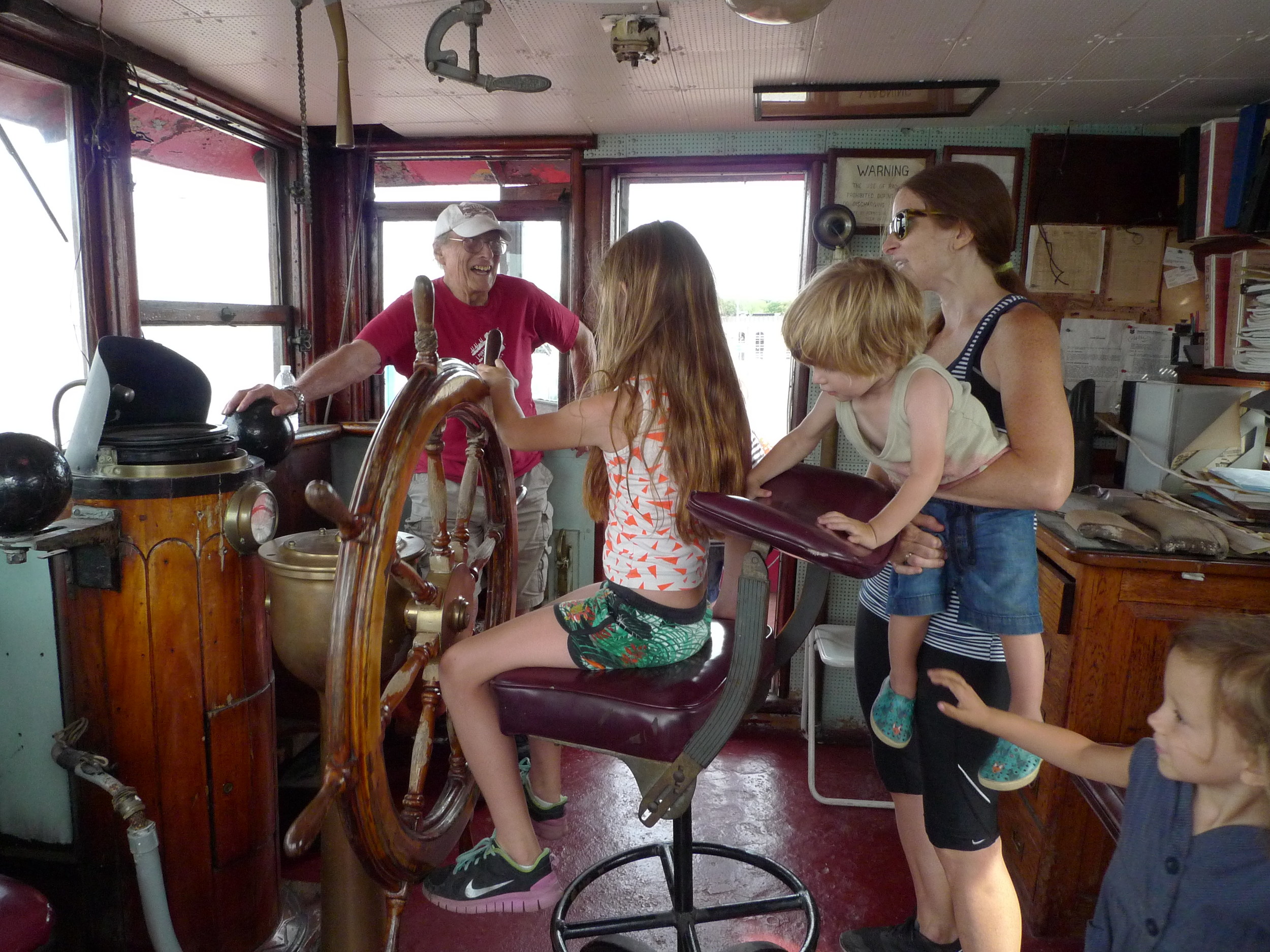
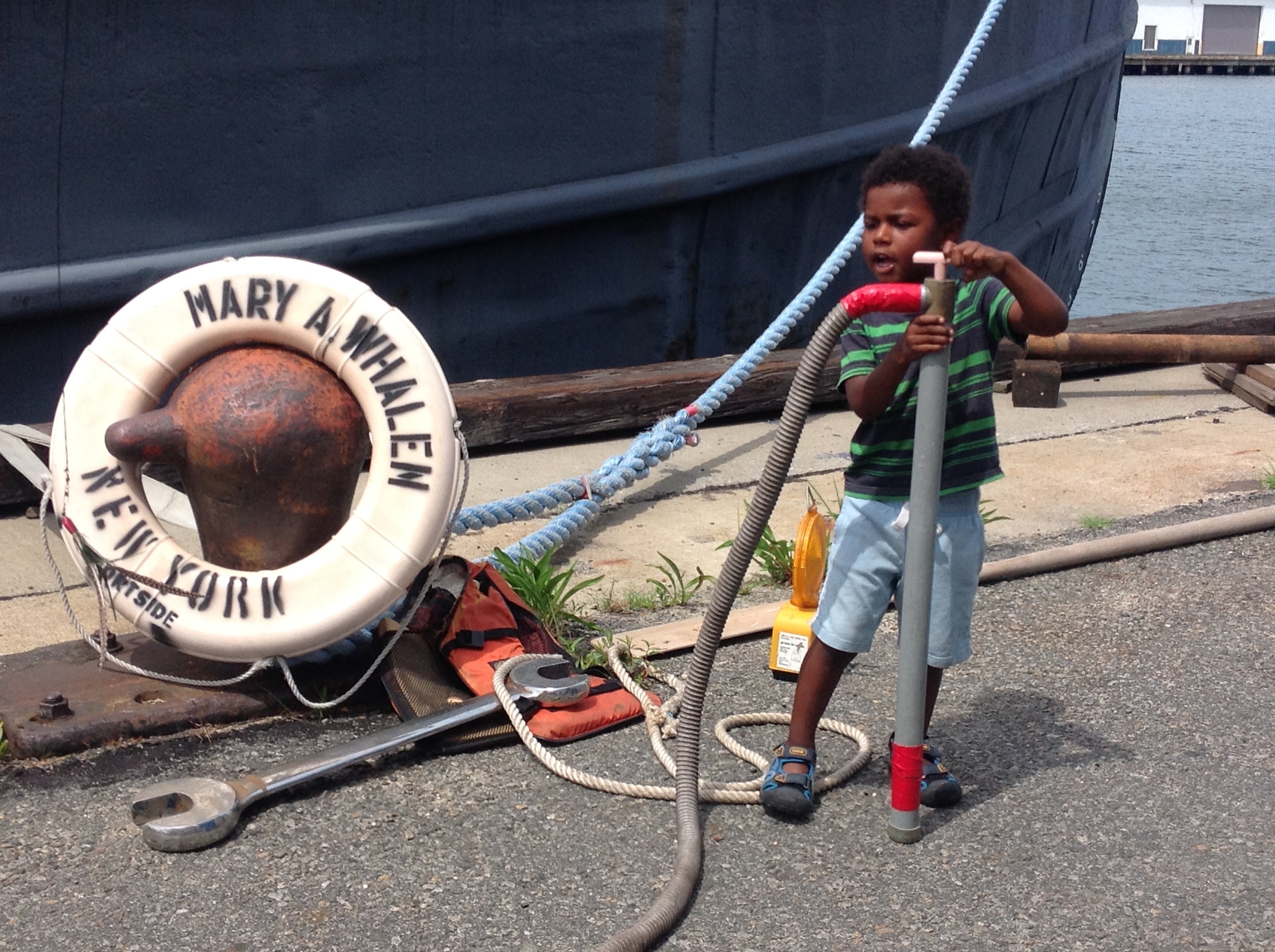
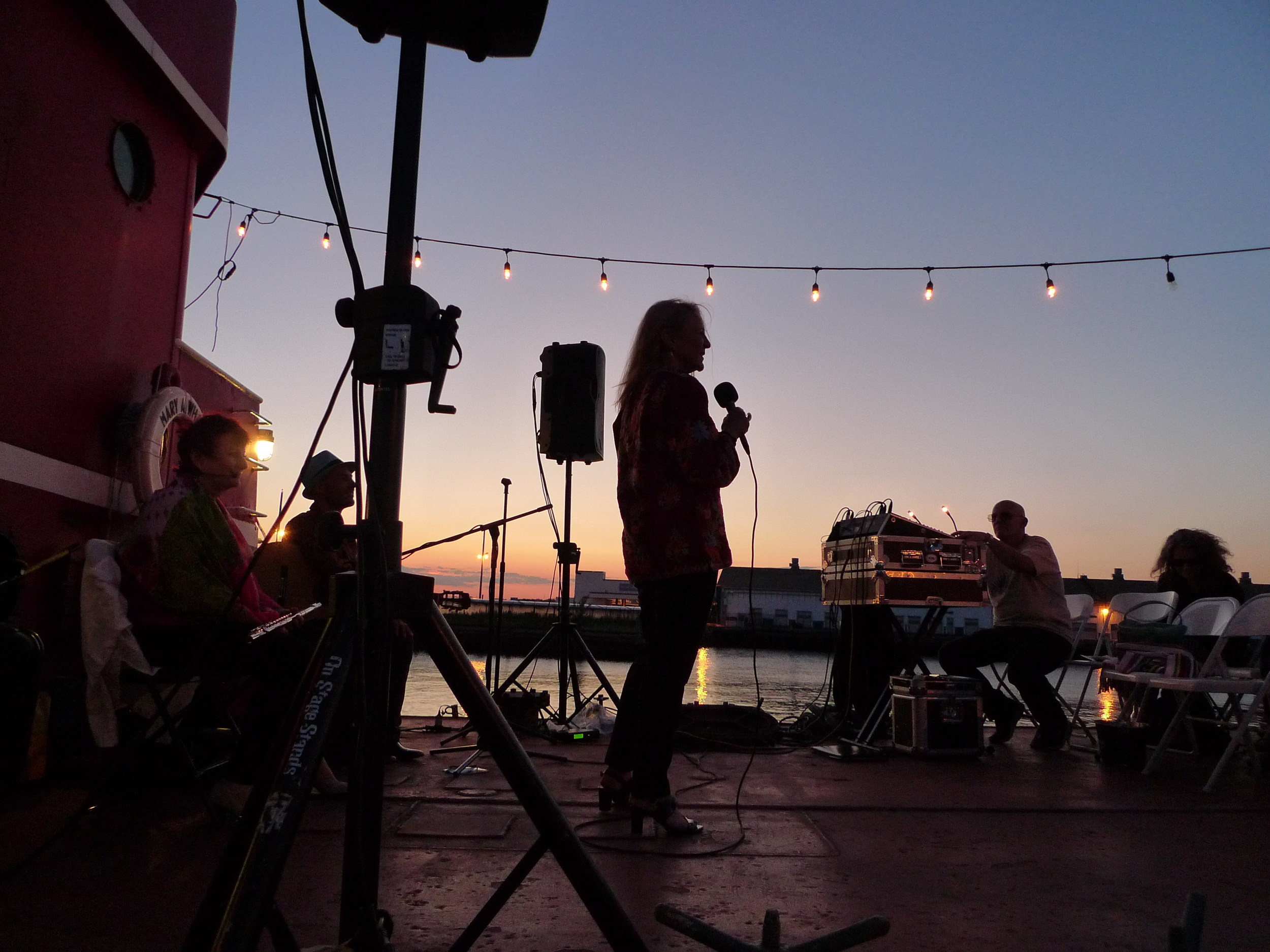
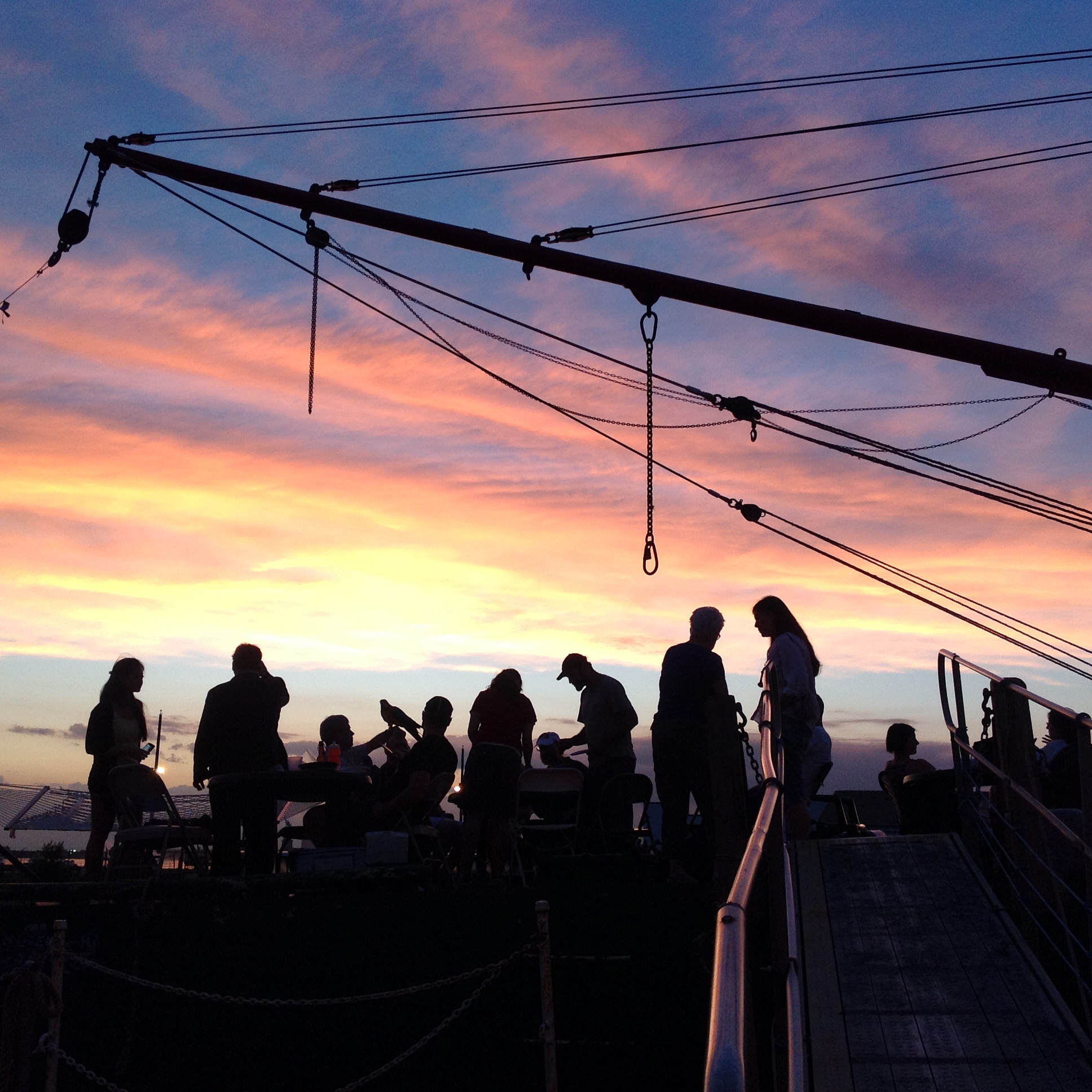
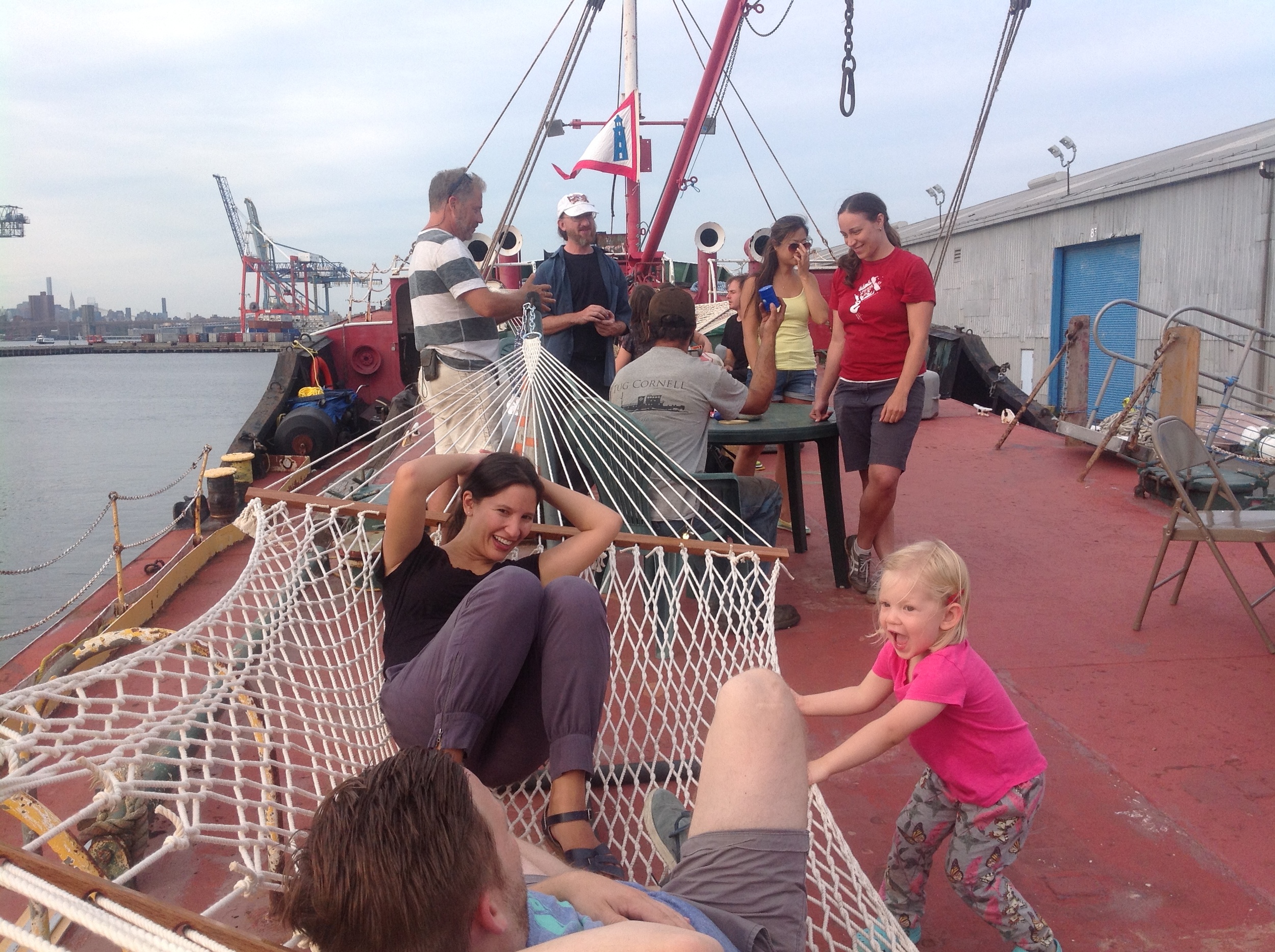
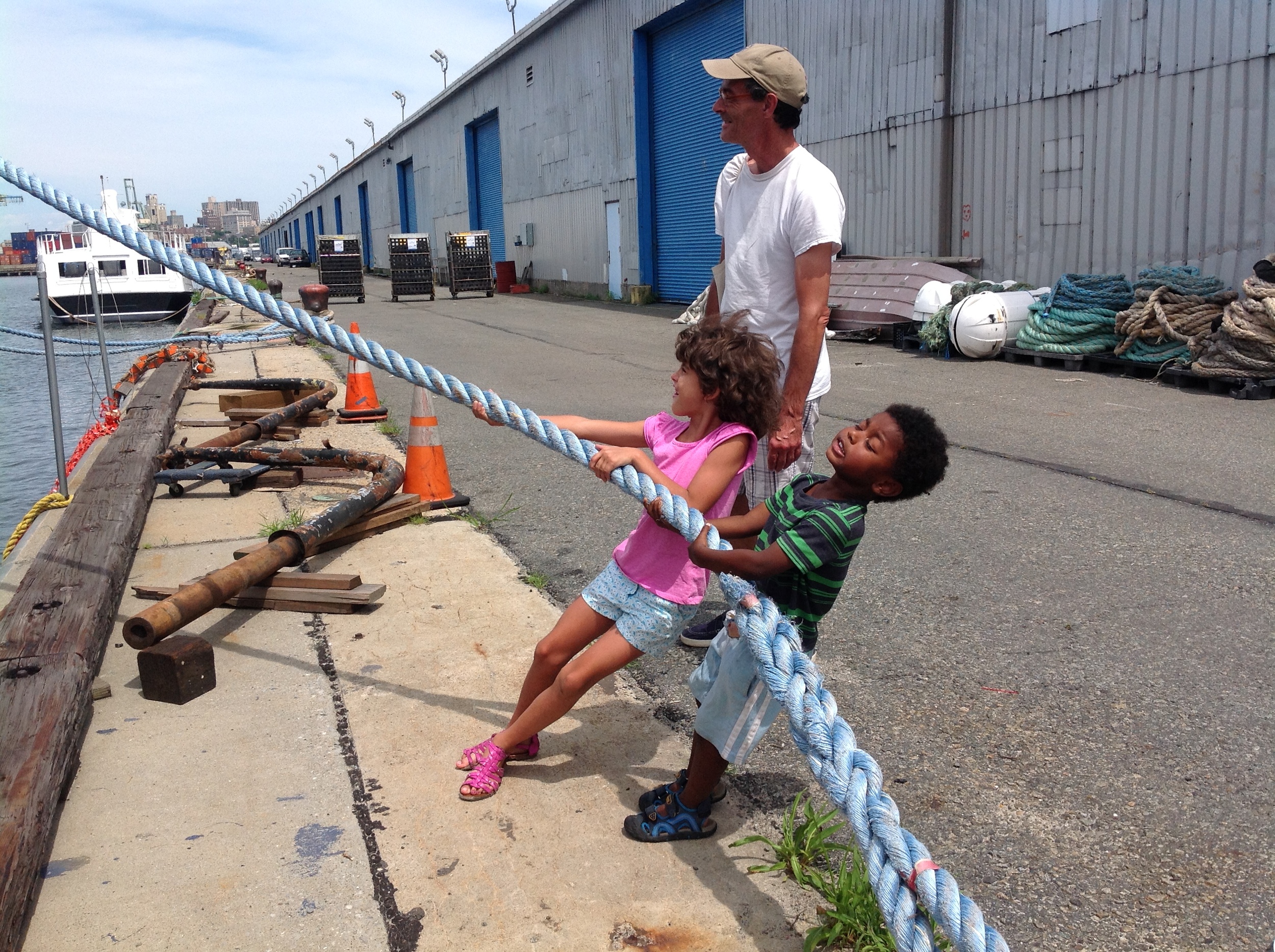
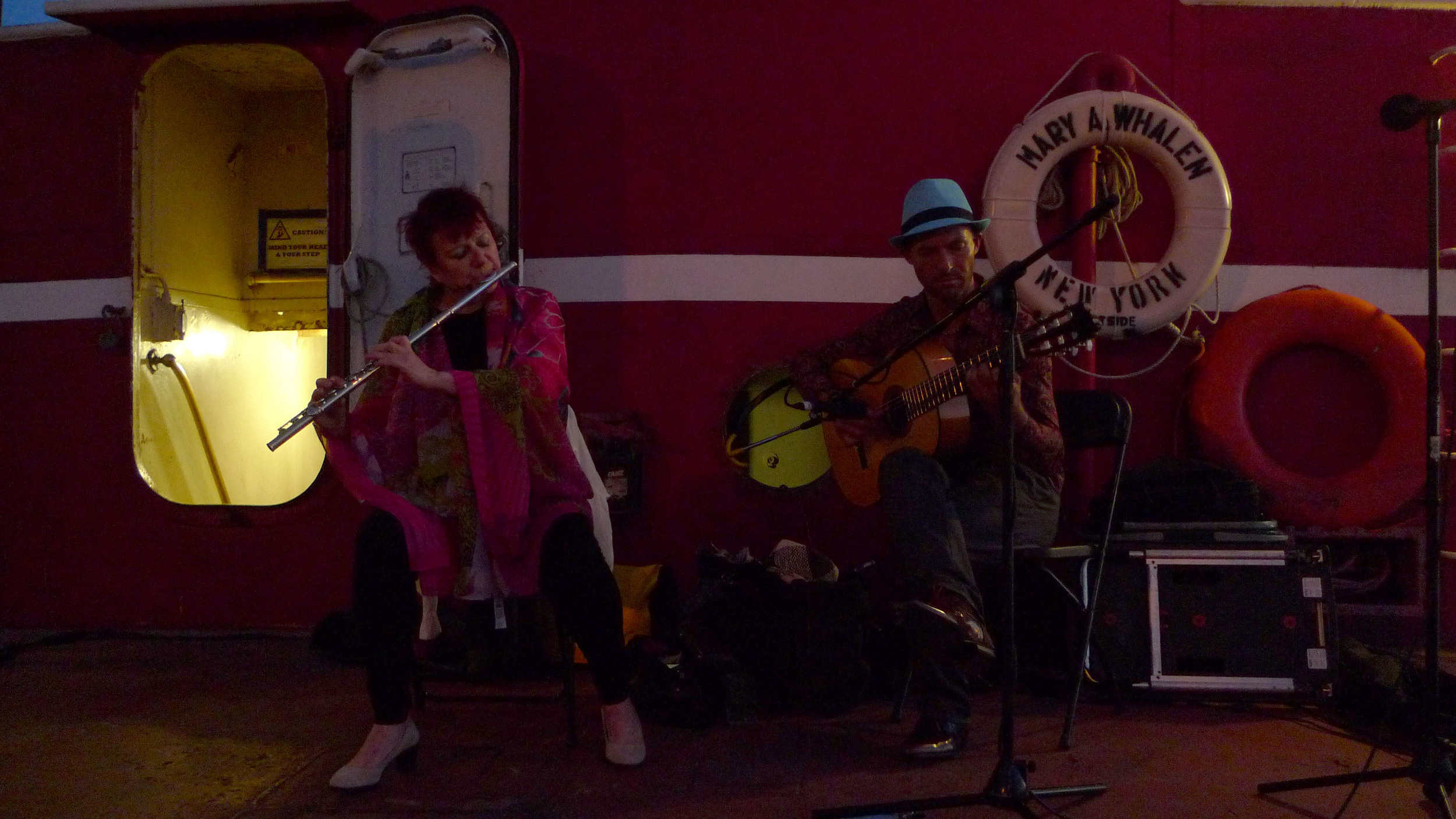
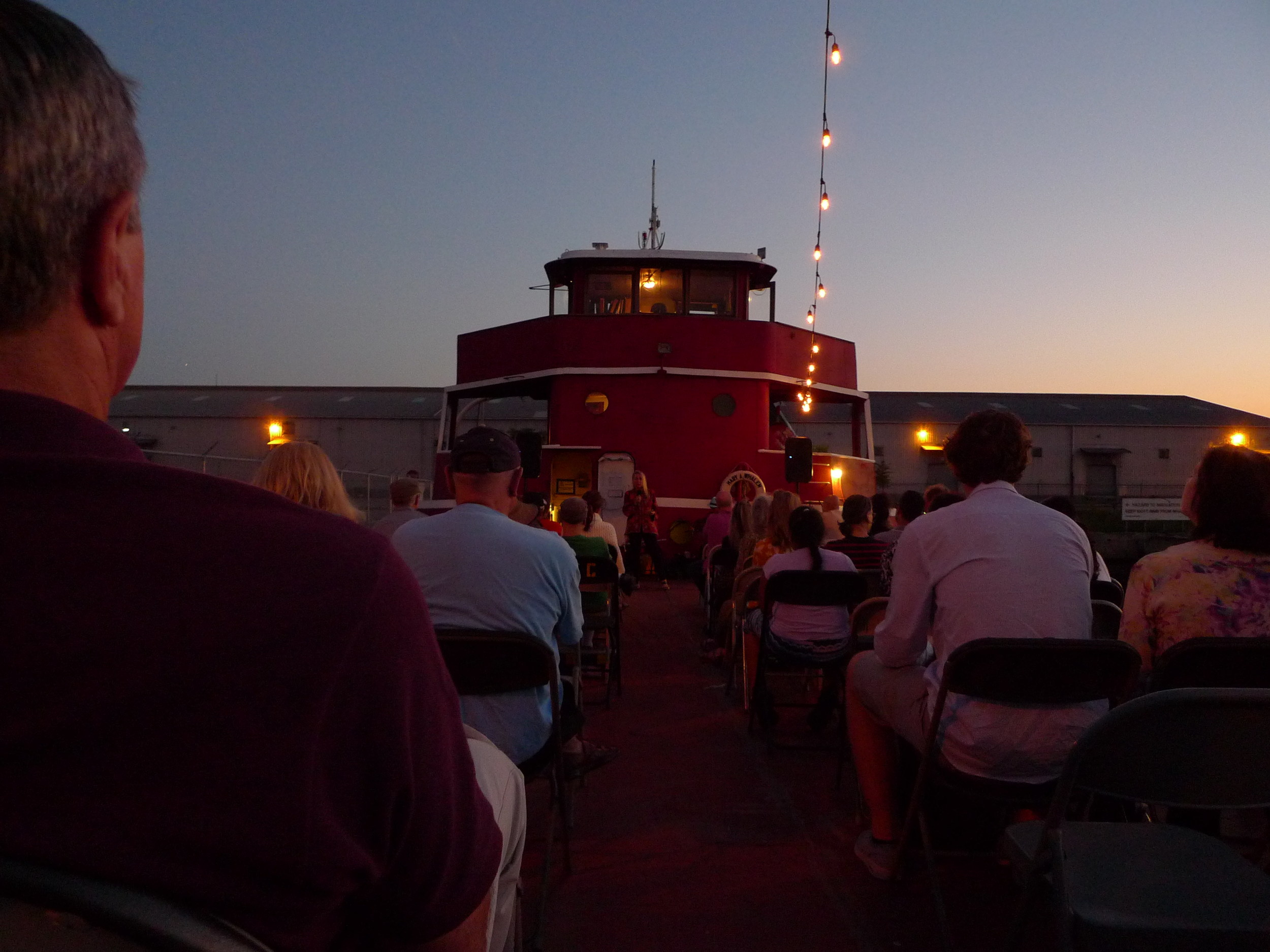
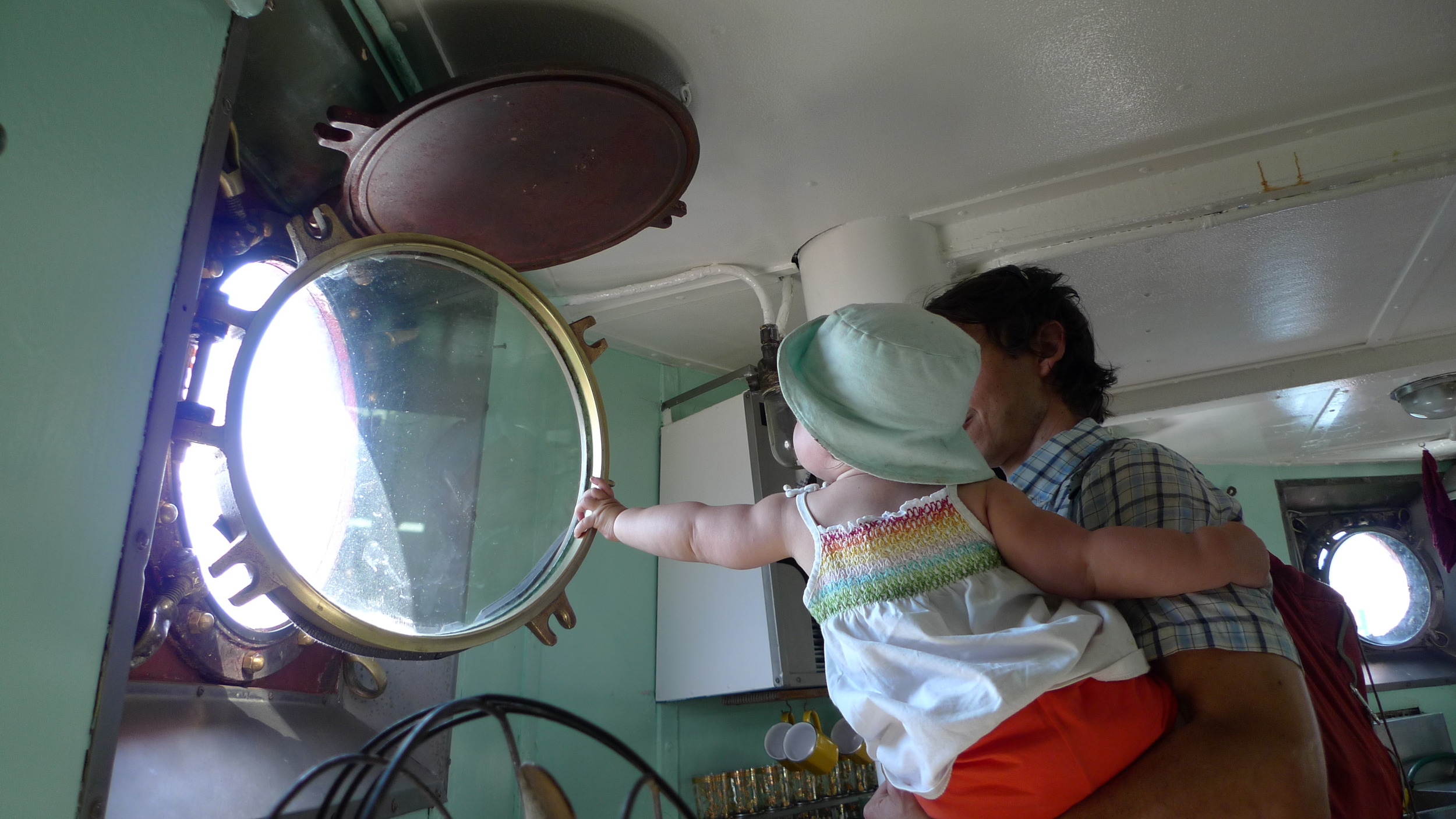
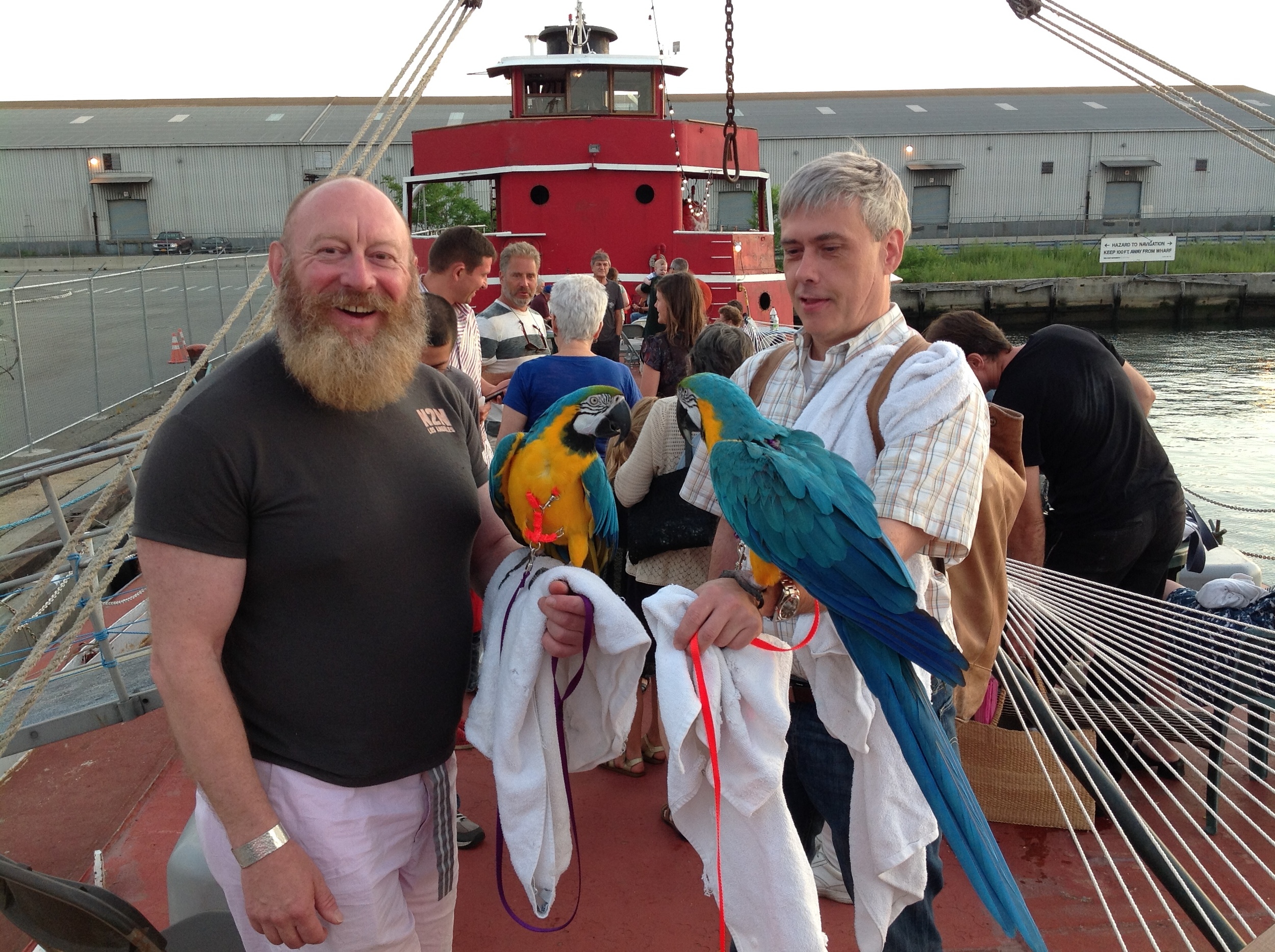

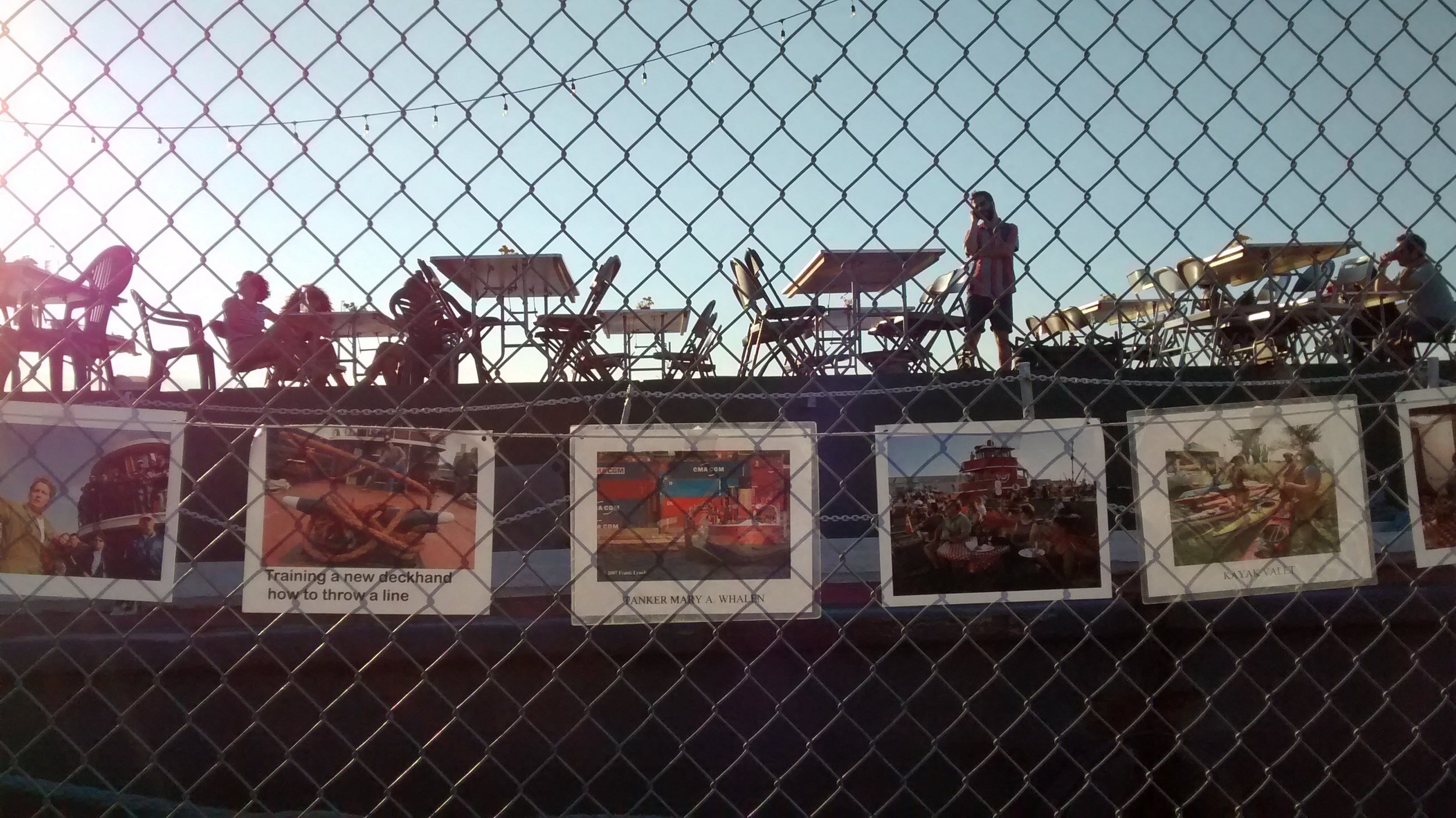
We secured $20,000 in funding from Councilman Carlos Menchaca to support our Red Hook WaterStories cultural tourism, placemaking and resiliency project. We were invited to join a historic ship flotilla that celebrated Cunard's 175th anniversary and got community members in the parade via our partner, the historic tug CORNELL. We curated and ran a great POW! weekend with TankerTours, TankerTime and gifted flamenco jazz musicians who have offered to make this an annual event. We produced a distinctive multimedia history night with Norwegian Red Hook WaterStories with bluegrass musicians from Norway, history speakers, and vintage video. Out shipcat Chiclet has become an attraction, with a growing fan club of regulars who come by to see her.
Volunteers repainted three cabins! Thank you, volunteers! Three summer interns from WHSAD did enormous work restoring the teak rail around the wheelhouse. The painters' union District Council 9 will repaint the exterior as a training excercise with paint donated by International Paint. DC9 scoped out the job, did some prep work, and laid plans for painting in 2016.
History runs through so many of our programs: all events on the ship, programs such as our Norwegian Red Hook WaterStories night, info content we share on our Facebook and Twitter, our blogposts such the one about the important sale of slave ERIE ship in Atlantic Basin which marked an important step in the end of slavery in the USA. In 2015, we added considerably to Mary A. Whalen history: more former crew members found us (thanks to our new home): Engineer Bill Siebert who works on a Vane tug and retired, 86-year old, former relief captain Thomas J. Smith. Captain Smith donated his maritime papers to us, and we have taped hours of interviews with him. A big boost in the history department was the visit by Scott Gellatly and his wife Pat. They ran a waterborne fuel transportation company years ago and almost bought the MARY. The Gellatlys donated photos, recorded hours of interview and brought along retired engineer Bryan Sinram, another trove of history, who had worked for Eklof, the company that ran the MARY WHALEN for years. Walter Barschow donated the folk painting of the MARY aground in the slide show above and gave us leads on Red Hook WaterStories about his family that ran a scrap yard for decades, founded by his German immigrant grandmother. Karen Dyrland and John Weaver donated another large cache of photos, letters and documents from Alf Dyrland, Captain of the MARY from 1962-1978. And, our home, the historic tanker MARY A. WHALEN turned 77!
PortSide continued to inspire filmmakers, painters and multi-media artists. Most find us because they can now see us. The MARY A. WHALEN is visible from our new friends and partners Pioneer Works which leads to a steady stream of artists coming to brainstorm, photograph, get ideas, one even collects salt water for a printing project. We gave the title to the documentary film BLUESPACE and appeared in it. We invited painter Jim Ebersole to memorialize our final week in the Red Hook Containerport.
This important work does not generate inspiring, cuddly or sexy photos. It involves a slew of emails and hundreds of conversations that advance our vision for bringing change to NYC's waterfront. Some highlights: Our President Carolina Salguero was appointed to the Sunset Park Task Force whose first task was to advise the EDC on creating an RFP for SBMT. How's that for alphabet soup! The Task Force continues to meet to shape the Sunset Park waterfront and industrial waterfront district. PortSide provided info and advice on the siting of a Citywide ferry stop in Red Hook. We are engaged with the ongoing work of Red Hook's NY Rising committee. We had a photogenic policy gig by being a stop on Alex Washburn's OHNY Resiliency bike tour.
Getting our new home in Atlantic Basin, has provided PortSide NewYork with much needed stability and allowed us to turn energies to growing PortSide's capacity. We grew the team with 2 board members and 4 advisory board members. We completed the long slog of paperwork of a FEMA Sandy Alternate Project application, along with other important funding applications. We were awarded $20,000 by Councilman Carlos Menchaca to support our Red Hook WaterStories project. In Late October, PortSide launched a year-long growth campaign #GetOnBoard. In December, we were awarded a competitive Regional Economic Development Council grant of $49,500 via the New York State Council on the Arts with the support of Governor Andrew M. Cuomo and the New York State Legislature. We scored new major sponsors in the Weather Channel and International Paint. There is strong growth in the number of entities reaching out to get involved: we have heard from college community service programs, schools, teachers and individuals.
Please donate now and support our momentum!
Sanding and painting needed in this executive suite asap. a false plywood floor has been cut and painted and needs to be installed after other surfaces are painted.
PortSide NewYork is preparing to have the historic ship MARY A. WHALEN be publicly accessible by summer. She and we will then be accessible for several years in a row, a real breakthrough after 10 years of operating as a pop-up in continual negotiations for short term permits. We hope you are as excited by this news as we are!
We could use some help getting ready, especially because the lingering winter weather delayed painting interior spaces on the ship before we moved our offices back aboard on April 30th.
Come enjoy spring weather on the waterfront and lend a hand. It's fun here! Join us!
To get involved, call 917-414-0565 or email portsidenewyork@gmail.com. More about volunteering in general here.
Finish painting the Captain's cabin. Sand and paint the Assistant Engineer's cabin below (currently the office of our President Carolina Salguero). Sand and paint the Tankermen's and Chief Engineer's cabin.
We need to move stuff around on the boat and move stuff off the boat. Things in the Tankermen's cabin go up to Captain's cabin once painting there is finished (it's almost done.) Contents of Chief Engineer's cabin are being taken off the boat to make space. Some stuff (some small, some heavy) goes into storage in the cargo tanks (that all involves fun with rigging). Btw, did you know that schlepp comes from the German word for tugboat?
Can you organize stuff? Like to clean?
Things have been piling up in main office space (two joined cabins) since the end-of-year Rigging Olympics and especially since we moved out of our shoreside office yesterday. We need to pack up and archjve some things until we can install better storage and desk system.
this is the fidley after yesterday's move of office from shore to ship. all t his has to get put away and the fidley deck needs a second coat of paint.
We seek a new office layout with custom desk surfaces and new storage units for our main shipboard office space below (two cabins joined by the previous owners). We have outgrown our current agglomeration of vintage steel desks and storage units. We have up to four people working in here at a time and much to store. Design needs to take into account that the ship moves.
We need to cut planks to put down a floor in another cargo tank to use it as a storage area. We need to install temporary plywood floors in two cabins used as office spaces.
Welding needed to finish sealing up the new hatch over cargo tank P2 which was cut late last year so we could store our large collection of vintage maritime artifacts down below. We have some other small welding repairs on hinges on steel doors etc. We are willing to pay for this work.
We could use some help with outreach to volunteers and event partners. This work requires a regular commitment of time over two months.
To get involved, call 917-414-0565 or email portsidenewyork(a)gmail.com. More about volunteering here.
Thanks!
Saturday 11/15/14 9am-5pm
Sunday 11/16/14 9am-5pm
Pier 9B, Red Hook Container Terminal, Brooklyn, 11231
Thursday and Friday, depending on crew availability
Lunch and pizza at end of day is on us. We can eat in the galley by the vintage stove or head to a local pizzeria; the work crew will vote to decide.
Enter port gate at Hamilton Avenue, Summit and Van Brunt Streets
Photo needed to enter. TWIC card holders especially appreciated!
RSVP by emailing portsidenewyork@gmail.com or calling 917-414-0565. If your tug is standing by and you're bored, you are welcome to tie up alongside and pitch in!
An INCREDIBLE amount of work has been done by POWERHOUSE volunteers, many of them who have taken time away from their own ship projects (be they not-for-profit or for profit vessels). There was great spirit and good humor while tons of steel were moved. Many thanks to you all!
Stevedore boss Sal came down the pier with other stevedores from the Pier 9B gang and hung another tire fender for us. Then, zip, zip, zip, with two forklifts they took all the stuff out of the shed that we thought we could move over the weekend. Thanks, guys!
Saturday 11/8/14, we had a very experienced work crew: Matt Perricone, Paul Strubeck, Amy Bucciferro, Christine Van Lenten, Mike Abegg, David Sharps, Peter Rothenberg and me, Carolina Salguero. Shipcat Chiclet loves projects like this and kept a close eye on all human endeavors. She is no dumb bunny, so she stays away from anything raised on boom or hoist and prefers to watch rigging from the pier. Activities in the shed, such as crate inspection and lumber moving, attracted her focused attention.
What we were moving and saving with this big project is artifacts from several significant Red Hook maritime businesses which closed in 2005, marking the end of an era: Todd Shipyard, Cowhey Brothers, and RMC Canvas and Rope, along with some odds and ends from here and there.
The artifacts include an array of marine hardware that will be used to explain rigging (over a span of decades) via a collection of diverse blocks, shackles, and turnbuckles. There are parts from WWII Liberty Ships, rope fenders; foundry molds, crates and crane plaques from the bridge cranes at Todd; a scale and line measuring device from Cowhey's, and more. Also, being moved are our event supplies (outdoor tables and chairs, signs, and sundry whatevers we use now and again such as Frank Hanavan's great costume version of the schooner PIONEER.)
Some large items of great importance to us include replacement parts of the engine on the MARY A. WHALEN, visible in the photo at right.
Paul Strubeck pulling out some pistons while Mike Abegg wears part of our Operation Christmas Cheer paraphinalia.
The marine business is so competitive that when the MARY A. WHALEN went out of service in 1994 due to a scored crankshaft, Eklof took the pistons, heads and rods out of the engine so that her buyers, Hughes Marine and Reinauer Transportation, dba Erie Basin Associates, could not repair the tanker and put her in competitive service. Just in case, Ekloff made them sign a covenant saying "we will not use the MARY A. WHALEN for fuel delivery service." She became their floating office, and a floating dock.
In 2008, PortSide NewYork bought spare engine parts from another Bushey tanker that had made its way to Seattle and was being scrapped there. Those parts were, unfortunately, in the shed when hurricane Sandy hit and now need some restoration work.
On Sunday, we were heartened when Nobby Peers, an engineer specializing in restoration work, told us the pistons looked really great! A few weeks after Sandy, we had pulled all the engine parts apart, and wiped everything down very liberally with WD40, four gallons of it!
The early birds, David Sharps, Christine Van Lenten and I moved things out of the forward engine room.
Paul Strubeck and Mike Abegg led the rigging and decided to not lift things aboard via whole pallet loads. Instead, they swung stuff over in smaller units, and got the big items out of the shed with a pallet jack. Peter Rothenberg preferred the hand truck. Amy Bucciferro assisted in moving things on the pier and on deck.
Matt Perricone's Saturday job was cutting the segment out of the deck (which will be converted into a hatch) so that we could load into one of the cargo tanks, which kept him busy a good part of the day. All tanks were vented and inspected before the job!
We threw a diverse set of tools at the job: chain falls, the ship boom, dollies, a hand truck, a pallet jack, an engine hoist, muscle and ingenuity and quite a few jokes.
By end of day, we had the overwhelming majority of things on deck, including the big items, the replacement heads and pistons for the engine in the MARY A. WHALEN.
Sunday, we had another extraordinary crew with Nobby Peers, Dan Goncharoff, David Sharps putting in a second day, Frank Hanavan, Jenny Kane who called her rigger friend Pete Betulia who joined us in the afternoon, Peter Rothenberg, and me, Carolina Salguero. Walter Dufresne and Mike Weiss were willing but the flu felled Walter and an truck break down kept Mike away.
Dan Goncharoff and Peter Rothenberg started out in the shed, trying to get the ends of the con rods and the bearings unbolted from the crankshaft in the lower engine block that was bought as a way to get another crank shaft (which sadly turned out to be damaged too). The nuts were seized, so Peter and Dan joined the work crew outside.
Frank Hanavan, David Sharps and Jenny Kane, and later joined by Peter Rothenberg, took on the task of laying down a plank floor inside the cargo tank. They developed their own intense cargo tank work crew. David and Peter where in the tank for a long while, and then David and Jenny became the chop saw team, with Frank the rigger running block and tackle and lowering things down most of the time.
The cargo tanks are really impressive spaces.
Nobby worked mostly alone for hours, with an occasional hand by me, until Jenny's friend Pete arrived. Nobby's mission was to get the heads and pistons into the engine room. He drilled a few holes in overhead flat bar beams in the entry companionway and in the fidley to hang two chainfalls and a come-along, and then hopscotched the heads in and down onto the engine one by one. The heads (from a 1951 engine) are slightly different from the original ones that would have been on the MARY, a 1938 engine.
Once Nobby was joined by Pete Betulia, the pace on the cylinder moving picked up; and sometime after dark, they started moving pistons in. Three of those made it to the engine room where Peter Rothenberg strapped them down on top of chocks he had cut at our on-deck chopsaw station. The last workers left around 10pm.
And then, just as I prayed would happen a few days ago, a tugboat friend arrived and tied up alongside, and I was able to get a hot shower. The plumbing on the MARY A. WHALEN is not yet restored.
At the two-year anniversary of hurricane Sandy, PortSide NewYork is telling our Sandy story, a story largely hidden, like so many in Red Hook. We believe our story offers hope and guidance for the future. That’s because our maritime perspective explains how we knew to prepare for Sandy, made us available to help Red Hook’s Sandy recovery, and is a knowledge base we want to share to make you safer from floods in the future.
PortSide NewYork was founded to help change awareness and use of NYC’s BLUEspace, the water part of the waterfront. New York City’s area is one third water, and contains 29 islands. PortSide’s goal is to create a place that will showcase what NYC’s waterfront can really be. Our ship, the tanker MARY A. WHALEN, is an ambassador in that goal and our endeavor to bring the community ashore and the community afloat, the maritime community, closer together. Here’s our Sandy story:
Please help us continue this kind of resiliency work and reporting. Buy a ticket to our fundraiser Tues 10/28/14 or donate
Thursday, 10/25/12, 1pm, Sandy minus 4.5 days, PortSide’s crew said good-bye to a class trip of first graders visiting the MARY A. WHALEN and started hurricane prep, punching our way thru the list of what we did for Irene the year before.
During the next four and a half days, we traded strategies with historic ships and modern workboats around the harbor. We all laid in food, water and fuel; tested generators; and moved our boats to safer places. PortSide curator Peter Rothenberg, shipcat Chiclet and Director Carolina Salguero are storm crew on the MARY A. WHALEN.
The maritime community obsessively followed marine weather reports. “Grim installments are burned in my memory,” said Carolina Salguero. “At Sandy minus 1.5 days, we learned an 8-foot surge is coming. At Sandy minus a few hours, I am readying for a 12 foot surge.”
Ashore in Red Hook, things were different. Sunday night, Sandy minus 24 hours, an email blast went out telling Red Hook which bars will be open and what movies are being screened. Carolina worried, “Is the community ashore prepping for Sandy? Has anyone evacuated?” PortSide’s maritime world felt separated from neighbors ashore by more than the containerport fence.
Peter Rothenberg was valiant. “When Carolina got word that the storm surge was expected to be 12 or 13 feet high, I had visions of the MARY tipping over onto the pier and emphatically agreed with the idea of securing a preventer line to the next pier 265 feet away.”
Due to preparations, our ship MARY WHALEN safely rode out the surge with our office aboard, enabling every form of Sandy assistance we delivered to Red Hook afterwards.
Peter and Carolina came ashore on Wednesday afternoon to discover a devastated Red Hook, and immediately decided that PortSide’s urgent search for a publicly-accessible homeport was flooded to a standstill and that we would help Red Hook until waterfront sites recovered enough for us to resume real estate talks.
Adam Armstrong, Pioneer Street resident and writer of the blog “View from the Hook” describes what happened next, “PortSide came ashore, quickly set up shop at 351 Van Brunt Street and proceeded to make a base - a visible and accessible storefront - from where they could reach out, provide information, resources and assistance to their land lubbing neighbors, most of us who were desperately trying to recover from the immense damage that had been done to our homes and our unique, waterfront neighborhood. Carolina Salguero and her team of volunteers co-ordinated clean-out crews and tradesmen to go and physically assist our residents, and they gathered and disseminated information about anything they though would be helpful - FEMA, legal assistance, insurance matters, Con Edison, National Grid, the Rapid Repairs program, etc., and provided a connection to our representatives in government. On many of these matters, PortSide organized meetings and reached out to our residents, and in the case of our street - Pioneer Street – Carolina co-ordinated the creation of a comprehensive contact list so that everyone on our block could share information and provide support to each other. It was - and still is - a wonderful way for the residents of Pioneer Street to keep in touch and get updates on our street's recovery.”
What made that work possible was the selflessness of three people PortSide is honoring at our fundraiser on Tuesday, October 28 at Hometown. Victoria Hagman donated Realty Collective’s storefront and utilities at 351 Van Brunt, despite suffering extensive flood damage herself. Park Slope electrician Danny Schneider walked into 351 and offered free labor. PortSide coordinated his work, and Danny reports that he inspected and certified 60 buildings and repaired some two dozen for just the cost of parts.
Our third honoree, our Curator Peter Rothenberg worked both ends of PortSide’s recovery story, the prevention that saved the MARY WHALEN and the aid work after the storm of setting up and running 351.
Peter, Carolina and Dan Goncharoff of PortSide ran 351 for a month and then continued a virtual aid station and other recovery efforts out of view. In April 2013, PortSide won a White House award for Sandy recovery work, and in July, the New York State Senate honored our work.
Carolina began attending resiliency conferences. Summer 2013, she was asked to become a member of Red Hook’s NY Rising committee to create local resiliency plans. PortSide staff and interns did research supporting the committee (which includes bone, two, three, and four and several pages on our website) during the committee's eight months of work.
One of Carolina’s NY Rising goals was to inject maritime issues into the discussion, hoping the State NY Rising process could influence a state agency, the Department of Environmental Conservation (DEC), so waterfront infrastructure in NYC can be more repaired and built for both resiliency and everyday operations. Carolina also proposed the solar-powered emergency lights for NYCHA housing which are in Red Hook’s plan and are being considered for other NYCHA developments. “I think the NY Rising committee work is good. Red Hook distinguished itself for what we put in our plan,” says Carolina; but plans are hidden assets for most people until they are built.
Looking back on PortSide’s two years of Sandy-related work, for the sake of Red Hook’s planning better for the future, we would like to talk about some hidden Sandy stories of need and success we found in the course of our recovery and resiliency work.
PortSide’s recovery work helped many people who don’t get media coverage and whose cases deserve more attention: People without an advocacy group, without on-line fundraising. People who aren’t comfortable using computers and needed Peter’s help to complete digital forms. People in mixed-use buildings that don’t fit FEMA homeowner funding guidelines. Renters who are not in NYCHA, and so are not in the media and political spotlights. Seniors, immigrants. People whose divorce, estate and tax situations complicated filing for aid and kept them from speaking up in public meetings. People who are private about their needs in general.
We learned that some affordable flood prevention was possible: The owners of Metal & Thread used a few hundred dollars of hardware store supplies to keep water from coming into their storefront and through the sidewalk hatch -- though their cellar suffered water leaking through the foundation from the empty lot next door. Some tugboat crews saved their cars by moving them from Erie Basin to the second floor garage at Home Depot, above surge level.
IKEA’s contribution needs more attention. IKEA gave and gave and got no media coverage until the Sandy’s one year anniversary when their $250,000 investment in solar powering the Rec Center netted some articles.
Inland Red Hook is so disconnected from maritime Red Hook that the latter’s role in recovery is not discussed. For example, Jim Tampakis’ business Marine Spares was significant in pumping out the Brooklyn Battery/Hugh L. Carey tunnel. Vane Brothers provided hoses to the Hess fuel terminal at the foot of Court Street so home heating oil could be delivered. Both firms did that despite flood damage to their offices and mechanical shops.
PortSide feels the gap between inland resident and mariner is acute when we heard residents say “They told us to evacuate for Irene but nothing happened” and “I didn’t know there were two high tides a day.” We conclude that people ashore poorly understand marine weather reports and don’t know where to get them.
In comparison, mariners understand how to live with water, and how to prepare for hurricanes. They do the post-flood work of pumping tunnels, building ferry terminals and running emergency ferries, fixing bulkheads, clearing the harbor of debris so ships can import products as diverse as fuel, orange juice, new cars, bananas.
To bring maritime voices to people ashore, PortSide plans programs to help folks develop coastal living and flood prep skills, such as educational events with actual mariners, exhibits, and creating a children’s book with our shipcat Chiclet as a resiliency narrator talking about riding out Sandy on the tanker.
Andrea Sansom, who founded the Red Hook flood mitigation Google group, sees the need, “We all love living at the water, and PortSide is here to help bring understanding to living with the water.”
Our ship is a great tool for this. Our tanker MARY A. WHALEN is now a maritime symbol of resiliency, in contrast to the tanker JOHN B. CADDELL, Staten Island’s symbol of Sandy, which went aground and had to be scrapped.
A hidden Sandy story PortSide feels acutely is that of our own Sandy damages. An electrical short left us facing thirty-five nights of relying on flashlights and one 15-amp extension cord attached to a little gas generator. Sandy damaged the Sheepshead Bay house of our staffer John Weaver keeping him home for many months. Everything PortSide had off the ship (antique crane, 60’ dock, electrical transformer, restoration engine parts, historic artifacts and documents, special event equipment and furniture) was flood-damaged or floated away. Our FEMA worksheet totals some $340,000, and we are still deep in that paper chase, starting six months late because we were misinformed that we don’t qualify.
A massive Sandy effect on PortSide was the stalling of our urgent search for a homeport. We need a place to fulfill our mission, earn revenue, and run programs. Resumption of real estate negotiations took many, many more months than we expected, and remains a major strain on PortSide.
PortSide is now focused on the future while celebrating the good in recovery. Come join us in that spirit at our fundraiser on Tuesday, October 28 at Hometown Bar-B-Que. Join us in honoring our partners in Red Hook’s Sandy recovery: Victoria Hagman of Realty Collective, Danny Schneider the electrician, and Peter Rothenberg. Wear festive MARY WHALEN red and white. We look forward to talking with you there and, going forward, continuing the work we’ve collectively begun after Sandy in understanding our waterfront in all its complexity and potential!
PortSide was founded to bring change to NYC’s waterfront, to make the waterways better used, to bring boats to communities, to change NYC policy.
Via our visiting vessel program, and by inventing Kayak Valet, we have brought many boats to Brooklyn, but getting the permits and the access was crushingly tough (except for Kayak Valet which was a breeze, and we are thrilled that the term and practice is now common in NYC.)
Thanks to our eight-year real estate search to create a place called PortSide NewYork, a home for our MARY A. WHALEN and visting vessels of all types, we have studied and/or negotiated with over 20 sites in NYC. This means we know where the opportunities - and the obstacles - are. We are funneling what we’ve learned to policy makers, and will soon start a public awareness campaign.
The city has piers that are designated for boats that were not built well for boats. The city has rules that add other layers of impediments.
Did you know that historic houses in NYC Parks have resident housekeepers, but New York City policy often prohibits resident shipkeepers who would similarly protect and maintain historic ships?
Did you know that NYC has a policy that states “boats block the view”? Buildings face no such absolute prohibition. Building zoning is calibrated to building function, size, location. “Boats block the view” has kept our MARY A. WHALEN off several piers. We’re out to change that rule, and others.
NYC has a reputation on the eastern seaboard for being a boat-unfriendly town. The thrust of NYC's first 20 years of waterfront revitalization, before Vision 2020, was getting people to the water's edge NOT onto, into or using the water itself.
The impediments prevent non-profit and commercial marine operators alike. They prevent major maritime festivals and single historic ships from visiting NYC, and prevent NYC's own historic ships from easily moving around the city to serve the public. Such impediments limit dinner, charter and excursion boat options, community sailing programs, marinas, kayaking programs and the workboat sector of the industrial waterfront.
Would you like more boats in your community? Summer ship camp? After school programs afloat? More maritime jobs? The chance to take a dinner cruise or leave on fly fishing cruise from your own neighborhood? Activity on a dormant pier in your neighborhood? Do you have a boat, boating program or business looking for a space in NYC? Leave us a comment below to let us know.
Support our fundraiser on Tuesday 10/28/14 “Resiliency is our HOOK.” Buy a ticket. Become a sponsor. Join the Host Committee and help sell tickets before the event. It will be a fun event with the rollicking Dixieland jazz of the Red Hook Ramblers and the great food and casual ambiance of Hometown Bar-B-Que restaurant. We greatly appreciate your support! As do the people and businesses who benefit from our resiliency work!
| Photo by Will Van Dorp of Tugster |
 |
| David Sharps (L) of Museum Barge, Pam Hepburn (R) of Tug Pegasus |
 | |||
| School group visiting the Museum Barge |
 |
| Teens from Chinese American Planning Council during Maritime Adventure Program on the tug Pegasus |